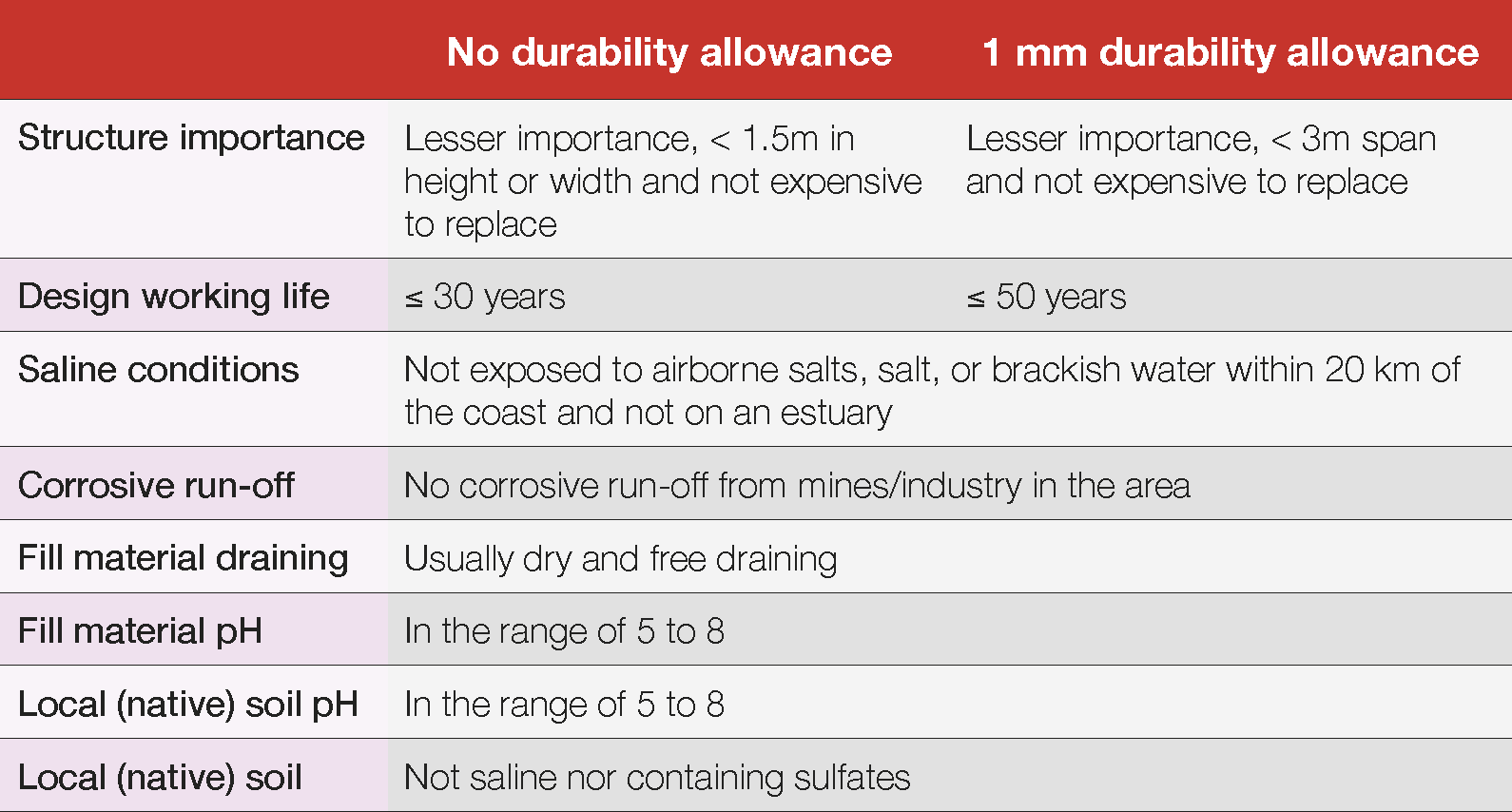Galvanized steel embedded in soil
Hot dip galvanizing is commonly embedded in soil in a range of applications, with both partial and full embedment having many successful examples.
Numerous different soil compositions exist in Australia and New Zealand, with the differences in physical and chemical properties between soils leading to corrosion rates that are rarely uniform between locations.
Soil Corrosion Rates: Long-term in-situ investigations in Australia and overseas of over 50,000 buried corrugated metal structures and other steel items allow the durability of hot dip galvanized coatings and steel structures to be estimated with some confidence. Galvanizing usually performs well in soil that is sufficiently free draining to maintain a moisture content below 20%, with typical average HDG loss rates from 2 to 6µm/year and steel loss rates once the HDG coating is expended from 10 to 20µm/year. As time passes the corrosion products usually build up on the surface of the galvanizing, leading to a slower corrosion rate after the first couple of years. This effect continues when the last of the zinc has corroded, leaving the underlying steel with a slower corrosion rate than steel that was not initially galvanized. Zinc also corrodes slower than steel in soil and prevents insidious pitting corrosion which commonly occurs on bare steel.
Two Australian and New Zealand Standards are of interest when determining how exposure to soils will affect corrosion rates. AS/NZS 2041.1 provides in-depth information on the soil’s corrosivity to buried metal corrugated structures (including galvanized steel) and how engineers can design for durability in the soil’s environment. AS 2159 provides requirements for the durability design of piles, using a similar method to AS/NZS 2041.1.
AS/NZS 2041.1 contains both simplified and detailed approaches to designing for durability in soil. If a steel corrosion allowance is included, the design should consider the design requirements from AS 4100 or NZS 3404.1.
Durability Allowance: The durability allowance required on bare steel is given explicitly when using the simplified design method from AS/NZS 2041.1 and can also be determined from the estimated life of the zinc coating and steel loss rate using the detailed design method. Structures embedded in soil are commonly designed with an acceptable steel corrosion loss of 1mm in addition to the structural requirements, although the allowable steel loss should be determined by the engineer for each design based on the local soil corrosivity. The thickness of the steel can be modified to ensure the member will meet the required service life and the galvanized coating is usually thicker when the thickness of the steel is increased which provides extra durability.
Simplified Durability Design: The simplified method is designed to be used for buried corrugated metal structures where the conditions of the installation and soil are known in general, but testing hasn’t been carried out on the site (the soil pH can be estimated using simple methods). If there is any uncertainty as to whether the conditions for using the simplified durability design are met, the detailed durability design procedure should be used. Table 4 lists the requirements for using the simplified method with galvanized steel, as well as whether a durability allowance is required for the base steel and Table 5 is used to determine the metal loss for this method.
Table 4 Requirements to use the simplified design method and resulting durability allowance

Table 5 Corrosion rates for zinc and steel in soil

Increasing Durability: Numerous steps can be taken to help a galvanized steel member embedded in soil reach the desired service life. Some or all the following measures may be required depending on the corrosivity of the soil and potential issues identified during the design process.
Preventing Ponding: When water can pool at the interface between the galvanized steel and soil, a localised corrosion cell can form which results in increased corrosion rates. Ponding can be minimised by building up soil (or concrete) around the interface to promote a natural water run-off and preventing water from running down the member to the interface. If ponding cannot be avoided through a design change, additional barrier protection is recommended at the interface.
Additional Barrier Protection: When only part of the member is embedded in soil or the member crosses a soil/groundwater interface, applying an additional coating is recommended to give enhanced corrosion resistance. At an interface between soil and the air there is a risk of accelerated corrosion from the level of compaction and oxygen availability, higher microbial activity in the first 200 to 300mm below the natural soil levels, detritus build-up around the base causing higher levels of contamination and wetness, and exposure to chemicals such as herbicide, fertiliser, or animal urine. Accelerated corrosion of the galvanized coating and pitting corrosion of the steel can occur, especially in aggressive atmospheres and wet environments.
For these reasons, where a steel structure is only partially buried, it is recommended designers consider additional protection for the first 250mm below and above the natural surface. Many protection methods can be applied over galvanizing to provide additional protection, including epoxy mastic coatings, very high build epoxy coatings, ultra-high build epoxy coatings, powder coating, elastomeric polyurethane or polyurea coatings, bituminous paint (these are often not suitable for UV exposure), corrosion inhibiting fabrics (wrapping tapes), or high-density polyethylene (particularly for piling).
Specialist advice should be sought to ensure the chosen system is suitable for above and below ground use, forms a complete seal against moisture being drawn between the coating and galvanizing by capillary action, and will have excellent long-term adhesion to the galvanized coating.
More information and other design methods are included in the GAA Advisory Note AN 42, Hot Dip Galvanizing Embedded in Soil.



